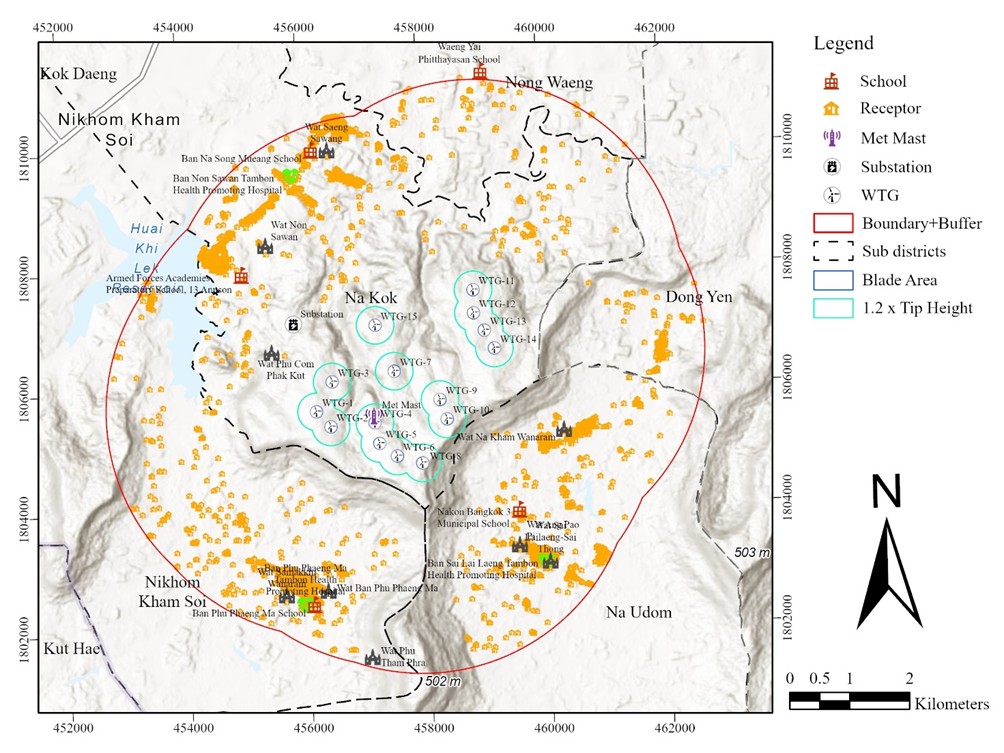Noise Emission Assessment of a Utility-Scale Wind Power Plant: Case Study of a 90 MW Wind Power Plant in Mukdaharn Province, Northeastern Thailand -
Main Article Content
Abstract
The noise impact of wind power plants is one of the major reasons for social opposition to wind energy development. The complex noise model (ISO 9613) was employed to model the noise generated by 15 GW165-6.0 MW wind turbine generator units based on the manufacturer-defined acoustic profile. The wind resource at a hub height of the wind turbine generators (144 m agl) was first predicted based on computational fluid dynamics flow modeling. The model noise levels were mapped using ArcGIS and twenty-two receptors comprising houses, temples, and other places at varying distances within the project boundary. Likewise, to compare the noise levels of the wind turbine generators with different noise levels, the ambient noise was measured at selected four receptors. The results showed that the predicted noise was less than 70 dB(A) in the vicinity of the wind turbine generators, decreased down to 40-45 dB(A) within the project boundary, and was in the range of 35-40 dB(A) in the community area. The compared results showed that the ambient noise exceeds the noise levels from the wind turbine generators at all four receptor sites. Hence, wind power plants would not cause any additional noise pollution. Such studies are vital to providing awareness to the public based on proven scientific evidence to gain the public's trust and mitigate social opposition to wind power plants.
Article Details

This work is licensed under a Creative Commons Attribution-NonCommercial-NoDerivatives 4.0 International License.
References
Cop, T.; Charter, T.; Zero, N.; Global, U.; Action, C. COP28 Net-Zero Transition Charter : Accountability mobilization for the private sector, Retrieved from: https://www.cop28.com/en/net-zero-accountability-charter. (accessed March 6 2024).
IRENA, International Renewable Energy Agency, Reneweble Energy Statistic 2023, Retrived from: https://www.irena.org/Publications/2023/Jul/Renewable-energy-statistics-2023. (accessed March, 6 2024).
IRENA, International Renewable Energy Agency, Future of Wind (Deployment, investment, technology, grid integration and socio-economic aspects), 2019 Retrived from: https://www.irena.org/-/media/Files/IRENA/Agency/Publication/2019/Oct/IRENA_Future_of_wind_2019.pdf. (accessed March, 6 2024).
Kamdar, I.; Taweekun, J. Assessment of Wind Energy Potential of Hat Yai (Songkhla), Thailand, IOP Conf. Ser. Mater. Sci. Eng. 2021, 1163(1), 012001. https://doi.org/10.1088/1757-899X/1163/1/012001.
Waewsak, J.; Chancham, WC.; Chiwamongkhonkarn, S.; Gagnon, Y. Wind Resource Assessment of the Southernmost Region of Thailand Using Atmospheric and Computational Fluid Dynamics Wind Flow Modeling, Energies. 2019 12, 1899. https://doi.org/10.3390/en12101899.
Tawinprai, S.; Polnumtiang, S.; Suksomprom, P.; Waewsak, J.; Tangchaichit, K. Modeling of Wind Energy Potential using a High-resolution Grid over Mekong Riverside Region in the Northeastern Part of Thailand, Theoretical and Applied Climatology. 2022, 150, 1587 – 1604. https://doi.org/10.1007/s00704-022-04235-w.
Niyomtham, L.; Lertsathittanakorn, C.; Waewsak, J.; Gagnon, Y. Mesoscale/Microscale and CFD Modeling for Wind Resource Assessment: Application to the Andaman Coast of Southern Thailand, Energies, 2022. https://www.mdpi.com/1996-1073/15/9/3025.
Tawinprai, S.; Polnumtiang, S.; Suksomprom, P.; Waewsak, J.; Tangchaichit, K.; Modelling, A. Approach for Evaluating the Wind Resource and Power Generation using a High‑resolution Grid at Selected Regions in the Northeast of Thailand, Modeling Earth Systems and Environment. 2023, https://doi.org/10.1007/s40808-022-01669-z.
European Commission EU, An Industry Perspective on Strengthening Onshore Wind Development in Thailand, https://ec.europa.eu/eurostat/statistics- (accessed March 6, 2024).
Rand, J.; Hoen, B. Thirty Years of North American Wind Energy Acceptance Research: What Have We Learned?, Energy Res. Soc. Sci. 2017, 29. 135 – 148. https://doi.org/10.1016/j.erss.2017.05.019.
Karasmanaki, E. Is It Safe to Live Near Wind Turbines? Reviewing the Impacts of Wind Turbine Noise, Energy Sustain. Dev. 2022, 69, 87–102. https://doi.org/10.1016/j.esd.2022.05.012.
Nissenbaum, M.A.; Aramini, J.J.; Hanning, C.D. Effects of Industrial Wind Turbine Noise on Sleep and Health, Noise Health. 2012, 14, 237–243. https://doi.org/10.4103/1463-1741.102961.
Jalali, L.; Bigelow, P.; Nezhad-Ahmadi, M.R.; Gohari, M.; Williams, D.; McColl, S. Before–After Field Study of Effects of Wind Turbine Noise on Polysomnographic Sleep Parameters, Noise Health. 2016, 18, 194. https://doi.org/10.4103/1463-1741.189242.
Smith, M.G.; Ögren, M.; Thorsson, P.; Hussain-Alkhateeb, L.; Pedersen, E.; Forssén, J.; Morsing, J.A.; Waye, K.P. A Laboratory Study on the Effects of Wind Turbine Noise on Sleep: Results of the Polysomnographic WiTNES Study, Sleep. 2020, 43, 1–14. https://doi.org/10.1093/sleep/zsaa046.
Leung, D.Y.C.; Yang, Y. Wind Energy Development and Its Environmental Impact : A Review, Renew. Sustain. Energy Rev. 2012, 16, 1031–1039. https://doi.org/10.1016/j.rser.2011.09.024.
Council of Canadian Academes, 2015. "Understanding the Evidence: Wind Turbine Noise". Ottawa (ON), Canada: The Expert Panel on Wind Turbine Noise and Human Health, Council of Canadian Academes, 180 p. (Experts Panel (alphabetical order): H.W Davies, Y. Gagnon, C. Giguère, T.L. Guidotti (Chair), S. Grace, R.V. Harrison, B. Howe, D.A. Johnson, K. Persson Waye, J.D. Roberts). https://cca-reports.ca/reports/understanding-the-evidence-wind-turbine-noise/ (accessed April 29, 2023).
Kongprasit, S.; Chiwamongkhonkan, S.; Ali, F.; Makhampom, P.; Gagnon, Y.; Waewsak, J. Environmental Impact Assessment of Onshore Wind Power Plants: A Case Study of a 50 MW Wind Power Plant in Northeastern Thailand, ASEAN J. Sci. Tech. Report. 2024, 27, 39-57. https://doi.org/10.55164/ajstr.v27i2.252058
Pollution Control Department, Noise disturbance measurement, https://www.pcd.go.th/wp-content/uploads/2020/06/pcdnew-2023-05-16_04-09-33_776771.pdf (accessed March, 6 2024).
Islam, K.D.; Theppaya, T.; Ali, F.; Waewsak, J.; Suepa, T.; Taweekun, J.; Titseesang, T.; Techato, K. Wind Energy Analysis in the Coastal Region of Bangladesh, Energies. 2021, 14, 1–18. https://doi.org/10.3390/en14185628.
Hu, W.; Yang, Q.; Zhang, J.; Hu, J. Coupled On-Site Measurement/CFD Based Approach for Wind Resource Assessment and Wind Farm Micro-Siting over Complex Terrain, IOP Conf. Ser. Earth Environ. Sci. 2020, 455, https://doi.org/10.1088/1755-1315/455/1/012037.
Tang, X.Y.; Zhao, S.; Fan, B.; Peinke, J.; Stoevesandt, B. Micro-scale Wind Resource Assessment in Complex Terrain based on CFD coupled Measurement from Multiple Masts, Appl. Energy. 2019, 238, 806–815. https://doi.org/10.1016/j.apenergy.2019.01.129.
https://asterweb.jpl.nasa.gov/gdem.asp (accessed March, 6 2024).
https://lddcatalog.ldd.go.th/dataset/ldd_21_01 (accessed March, 6 2024).
Howland, M.F.; Quesada, J.B.; Martínez, J.J.P.; Larrañaga, F.P.; Yadav, N.; Chawla, J.S.; Sivaram, V.; Dabiri, J.O. Collective Wind Farm Operation based on a Predictive Model Increases Utility-scale Energy Production, Nat. Energy. 2022, 7. https://doi.org/10.1038/s41560-022-01085-8.
GH and Partners. GH WindFarmer: Theory Manual. http://www.ccpo.odu.edu/~ klinck/Reprints/PDF/garradhassan2009.pdf.(accessed March 6, 2024).
GoldWind International Solution Department, Description of GW165-6.0 MW, Acoustic Performance Specification.
Chourpouliadis, C.; Ioannou, E.; Koras, A.; Kalfas, A. I. Comparative Study of the Power Production and Noise Emissions Impact from Two Wind Farms. Energy Conversion and Management. 2012, 60, 233-242.


